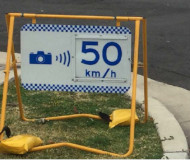10/26/2018
Australia: Audit Questions Speed Camera EffectivenessAustralian auditor recommends hiding speed cameras to boost revenue for the billion-dollar program.

A performance audit released last week by the auditor-general of New South Wales, Australia, was unable to come to the conclusion that automated enforcement has improved safety because of a rise in the number of traffic fatalities.
"There is limited evidence that the mobile speed camera program in New South Wales has led to a behavioral change in drivers by creating a general network deterrence," auditor-general Margaret Crawford wrote. "The results of overall network speed surveys vary, with recent improvements in some speed zones but not others."
To address these shortcomings, the report recommends hiding speed cameras by eliminating the use of signs that remind motorists of the speed limits and alert them to the presence of automated ticketing machines.
"While camera locations have been selected based on crash history, the limited number of locations restricts network coverage," the report found. "It also makes enforcement more predictable, reducing the ability to provide a general deterrence. Implementation of the program has been consistent with government decisions to limit its hours of operation and use multiple warning signs. These factors limit the ability of the mobile speed camera program to effectively deliver a broad general network deterrence from speeding."
Those factors also limit the revenue generated by a program that has nonetheless proved highly lucrative. In fiscal 2018, speed cameras issued 471,019 tickets, while red light cameras generated 173,423 citations for a combined profit of $187,555,718. The state allows the for-profit private companies that provide the camera equipment to keep $22 million a year. Over the past six years, the state government has pocketed $945,907,156 from automated ticketing. The report noted that the use of signs also cut into the revenue generated by the program.
"There are also additional costs associated with the signs, including the time for their set up and removal, and additional site maintenance costs," the report found.
A total of 940 locations have been approved for mobile speed camera use, but the auditor wants to see that more than doubled to 2500. The report found there is only one Roads and Maritime Services inspector in the entire state who verifies whether the private, for-profit contractor Redflex Traffic Systems is following operational procedures.
"The contractors are responsible for driving the mobile speed camera vehicle to the scheduled enforcement location, setting up the vehicle, signage and camera in accordance with operating procedures and ensuring that the camera is secured and operating correctly," the report explained.
A copy of the audit report is available in a 2mb PDF file at the source link below.


